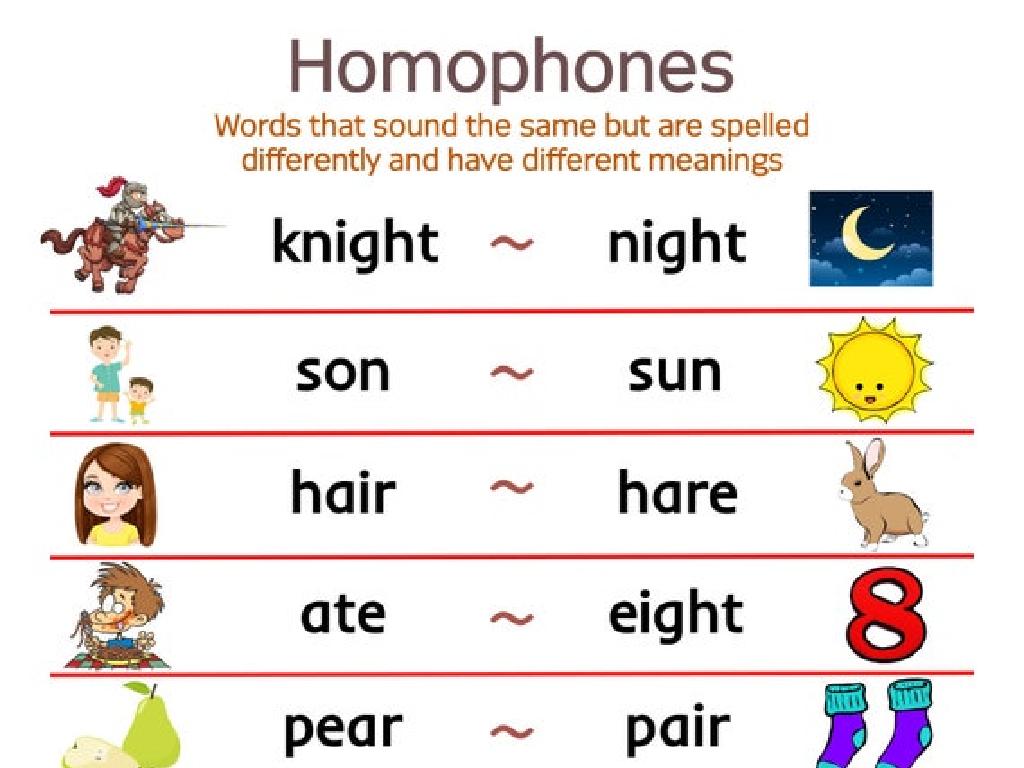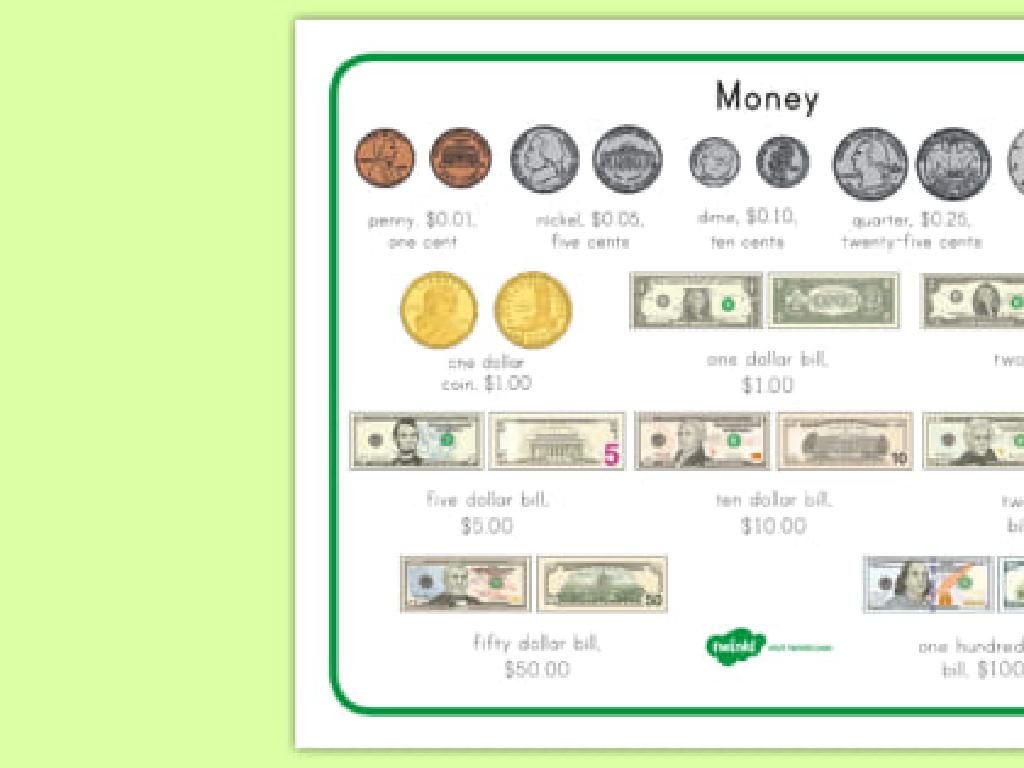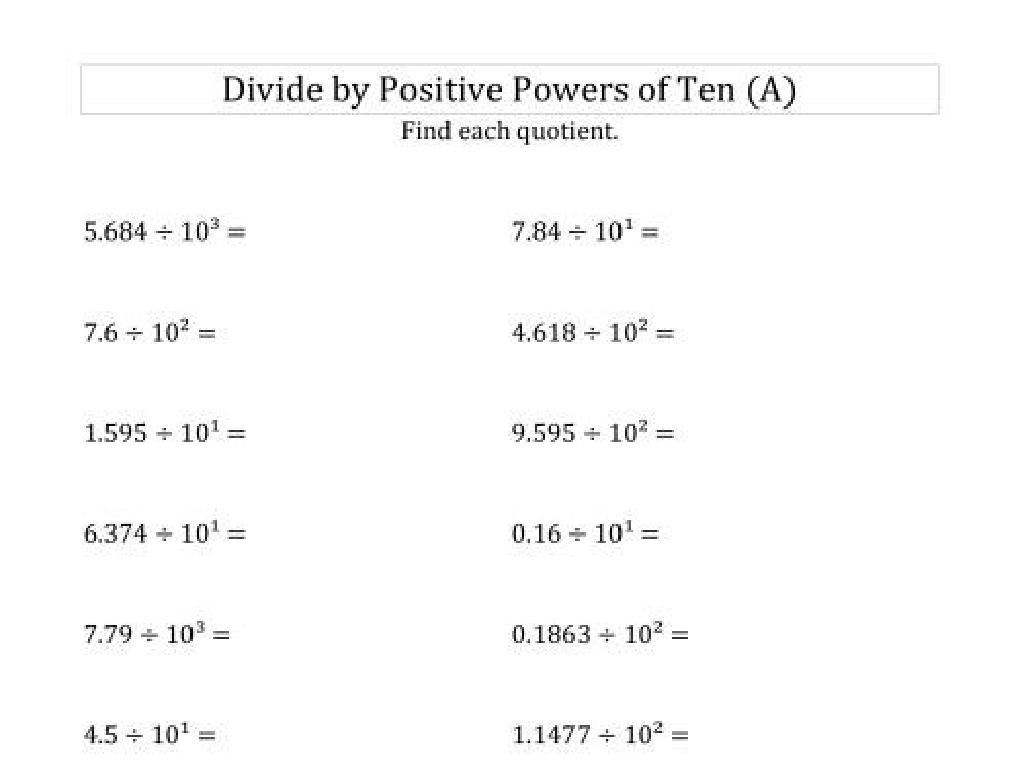Division With Decimal Quotients And Rounding
Subject: Math
Grade: Fifth grade
Topic: Divide Decimals
Please LOG IN to download the presentation. Access is available to registered users only.
View More Content
Division with Decimals
– Understanding decimal division
– Dividing numbers with decimals, just like whole numbers
– Importance of decimal division
– Helps in situations like splitting bills or measuring
– Real-life decimal division
– Examples: Money transactions or dividing lengths
– Rounding decimal quotients
– After division, round for easier numbers to work with
|
This slide introduces the concept of dividing with decimals, which is a crucial skill for fifth graders. It’s important to explain that dividing with decimals is not much different from dividing whole numbers and that the skills they’ve learned with whole numbers will apply here too. Emphasize the practicality of decimal division in everyday life, such as when dealing with money or measurements. Provide examples like dividing a dollar into cents or a meter into centimeters. Finally, discuss the importance of rounding decimal quotients to make the numbers more manageable in real-world scenarios, such as estimating costs or quantities. Encourage students to think of times they have encountered decimals in their daily lives.
Understanding Decimals
– Review: Decimals and place values
– Decimals represent parts of a whole, like cents in a dollar.
– Whole numbers vs. decimals
– Whole numbers are complete units, decimals are not.
– Decimals in daily life
– Money uses decimals: $3.75 means 3 dollars and 75 cents.
– Rounding decimal numbers
– Rounding decimals simplifies them, like $3.75 to $4.
|
Begin with a quick review of what decimals are and their place values to refresh the students’ memory. Highlight the difference between whole numbers and decimals, emphasizing that decimals represent fractions of a whole. Provide relatable examples, such as money, to illustrate how decimals are used in everyday life. Explain the concept of rounding decimals to the nearest whole number, and how it can make calculations easier and more practical in daily situations. Encourage students to think of other examples where they encounter decimals and the importance of rounding in those contexts.
Division Without Decimals
– Recap division fundamentals
– Steps to divide whole numbers
– Divide the dividend by the divisor to find the quotient
– Practice: 15 ÷ 3
– What is the quotient of 15 ÷ 3?
– Discuss answers and methods
– Review different ways to solve the problem
|
Begin with a brief review of division basics to ensure students recall the process of dividing numbers. Emphasize the terms dividend, divisor, and quotient. Then, guide students through the steps of dividing whole numbers without decimals, ensuring they understand the concept of evenly distributing a number. Use the practice problem (15 ÷ 3) to apply this knowledge. After students attempt the problem, discuss the correct answer (5) and the methods they used to arrive at it. This will help reinforce their understanding and prepare them for more complex division with decimals.
Dividing Decimals by Whole Numbers
– Placing the decimal in quotients
– Line up the decimal point in the answer with the decimal in the dividend.
– Divide decimals by whole numbers
– Place the decimal point before dividing, then divide as with whole numbers.
– Example: 4.5 ÷ 3
– 4.5 divided by 3 equals 1.5. The decimal point is directly above the decimal in 4.5.
|
When introducing decimals into division, it’s crucial to understand the placement of the decimal point in the quotient. Students should learn to line up the decimal point in the quotient with the decimal in the dividend before they begin dividing. For example, when dividing 4.5 by 3, they should place the decimal point in the answer directly above the decimal in 4.5 and then proceed with the division as they would with whole numbers. This slide provides a clear example with 4.5 divided by 3 to illustrate the concept. Encourage students to practice with additional examples and to check their work by multiplying the quotient by the divisor to see if they get the original dividend.
Dividing by a Decimal
– Understand division by decimals
– Convert divisor to a whole number
– Multiply both numbers by 10 until the divisor is whole
– Example: 6.75 ÷ 0.5
– 6.75 becomes 67.5 and 0.5 becomes 5, now divide 67.5 by 5
– Practice rounding decimal quotients
– After division, round the answer to the nearest whole number or decimal place as instructed
|
This slide introduces the concept of dividing by a decimal. Start by explaining the process of division and how it applies when dealing with decimal numbers. Emphasize the importance of converting the divisor into a whole number to simplify the division process. Use the example of dividing 6.75 by 0.5 to illustrate the concept, showing step-by-step how to multiply both the dividend and divisor to make the divisor a whole number. Finally, guide students on how to round their answers appropriately, depending on the context or instructions given. Encourage students to practice with additional examples to reinforce their understanding.
Rounding Decimal Quotients
– Understanding when to round decimals
– Learning the rules for rounding
– Look at the digit to the right of the place value you’re rounding to.
– Rounding practice: 3.142 to tenth
– 3.142 rounded to the nearest tenth is 3.1
– Why rounding is important
|
Rounding decimals is a key skill in mathematics, especially when dealing with money or measurements where precision to a certain point is required. Teach students that we round decimal quotients to make numbers easier to work with or when an exact number isn’t necessary. Go over the rules for rounding: if the number to the right of the desired decimal place is 5 or more, round up; if it’s 4 or less, round down. Use 3.142 as an example to show rounding to the nearest tenth, which would be 3.1. Emphasize the practicality of rounding in everyday life and in various professions. Encourage students to practice with more examples and to understand the significance of each decimal place.
Class Activity: Division Dash!
– Pair up for division problems
– Solve with decimal quotients
– Divide numbers ending with decimals
– Round answers to hundredth
– Use rounding rules for precision
– Present solutions to class
|
This activity is designed to encourage collaborative learning and practice with decimal division. Students will pair up, which promotes teamwork and allows them to assist each other. Provide a set of division problems that result in decimal quotients. Students should use their knowledge of division to solve these problems. Emphasize the importance of rounding to the nearest hundredth to practice precision. After solving, each pair will share their solutions, fostering a sense of community and allowing for peer learning. For the teacher: Prepare diverse problems of varying difficulty, ensure students understand rounding rules, and facilitate the sharing session to confirm correct understanding and methods.
Homework: Mastering Decimal Division
– Complete practice problems
– Solve the assigned problems to reinforce your understanding of decimal division.
– Review division tips at home
– Use the strategies learned in class to divide decimals successfully.
– Remember consistent practice
– Regular practice is key to becoming proficient in decimal division.
– Aim for accuracy and speed
– Work on solving problems correctly first, then improve your speed.
|
This slide is meant to wrap up the lesson on decimal division and to set expectations for homework. Students should complete the practice problems to reinforce the concepts learned in class. Encourage them to use the tips provided during the lesson to help them divide decimals accurately at home. Remind them that regular practice is essential for mastering any math skill. Emphasize the importance of accuracy before speed, and encourage them to check their work. For the next class, be prepared to review the homework, discuss any challenges faced, and celebrate successes. Provide additional practice problems for students who may need extra help and consider pairing students for peer tutoring.






